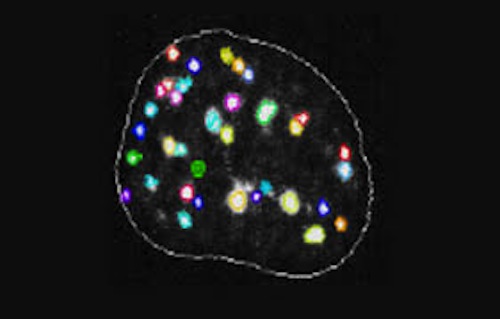|
|
Developmental Biology - DNA Repair
Repairing DNA Breaks in Aging, Cancer and MND
Experts discover a new 'toolkit' of proteins which can lead to repair of DNA breaks...
An accumulation of DNA breaks can cause ageing, cancer and Motor Neuron Disease (MND). However, a new finding out of the Universities of Sheffield and Oxford could help us repair such breaks.
Published in Nature Communications, research shows the protein TEX264, along with other enzymes, can recognise and 'eat' toxic proteins stuck to DNA and causing damage. An accumulation of broken and damaged DNA can stimulate cell ageing, cancer and neurological disease.
Until now, ways of repairing this sort of DNA damage have been poorly understood. But scientists hope to exploit this novel repair toolkit of proteins, in order to protect us from ageing, cancer and neurological disease.
These findings could have implications on chemotherapy, which deliberately causes breaks in DNA while attempting to kill cancer cells. Scientists believe targeting TEX264 protein may offer a new way to treat childhood cancers.
"Failure to fix DNA breaks in our genome can impact our ability to enjoy a healthy life at an old age, as well as leave us vulnerable to neurological diseases like Motor Neuron Disease (MND).
We hope that by understanding how our cells fix DNA breaks, we can help meet some of these challenges, as well as explore new ways of treating cancer in the future."
Sherif El-Khamisy, Professor, Co-Founder and Deputy Director of the Healthy Lifespan Institute, professor, Department of Molecular Biology and Biotechnology and
Neuroscience Institute, University of Sheffield, and co-leader of the research.
Oxford's research was supported by funding from the Medical Research Council, the Oxford Institute for Radiation Oncology and the Department of Oncology. Professor El-Khamisy's lab is funded by the Wellcome Trust and the Lister Institute of Preventative Medicine. Their work forms part of the research taking place at the University of Sheffield's Healthy Lifespan Institute and the Neuroscience Institute.
"Our finding of TEX264, a protein that forms the specialised machinery to digest toxic proteins from our DNA, significantly changes our current understanding of how cells repair the genome and so protect us from accelerated ageing, cancer and neurodegeneration. I believe this discovery has a great potential for cancer therapy in the future and we are already pursuing our research in this direction. I am very proud of my research team who initially discovered the involvement of TEX264 in DNA repair."
Kristijan Ramadan, Professor, University of Oxford, co-leader of the research.
The Healthy Lifespan Institute brings together 120 world-class researchers from a wide range of disciplines with the aim of slowing down ageing and tackling the global epidemic of multi- morbidity — the presence of two or more chronic conditions simultaneously - in a bid to help everyone live healthier, independent lives for longer while reducing the cost of care.
The next step will be to test if the behaviour and properties of protein TEX264 is altered in ageing and in neurological disorders such as MND.
Abstract
Eukaryotic topoisomerase 1 (TOP1) regulates DNA topology to ensure efficient DNA replication and transcription. TOP1 is also a major driver of endogenous genome instability, particularly when its catalytic intermediate—a covalent TOP1-DNA adduct known as a TOP1 cleavage complex (TOP1cc)—is stabilised. TOP1ccs are highly cytotoxic and a failure to resolve them underlies the pathology of neurological disorders; but, it is also exploited in cancer therapy where TOP1ccs are the target of widely used frontline anti-cancer drugs. A critical enzyme for TOP1cc resolution is the tyrosyl-DNA phosphodiesterase (TDP1), which hydrolyses the bond that links a tyrosine in the active site of TOP1 to a 3’ phosphate group on a single-stranded (ss)DNA break. However, TDP1 can only process small peptide fragments from ssDNA ends, raising the question of how the ~90 kDa TOP1 protein is processed upstream of TDP1. Here we find that TEX264 fulfils this role by forming a complex with the p97 ATPase and the SPRTN metalloprotease. We show that TEX264 recognises both unmodified and SUMO1-modifed TOP1 and initiates TOP1cc repair by recruiting p97 and SPRTN. TEX264 localises to the nuclear periphery, associates with DNA replication forks, and counteracts TOP1ccs during DNA replication. Altogether, our study elucidates the existence of a specialised repair complex required for upstream proteolysis of TOP1ccs and their subsequent resolution.
Authors
John Fielden, Katherine Wiseman, Ignacio Torrecilla, Shudong Li, Samuel Hume, Shih-Chieh Chiang, Annamaria Ruggiano, Abhay Narayan Singh, Raimundo Freire, Sylvana Hassanieh, Enric Domingo, Iolanda Vendrell, Roman Fischer, Benedikt M. Kessler, Timothy S. Maughan, Sherif F. El-Khamisy and Kristijan Ramadan.
Acknowledgements
The authors thank Paul Elliott for generating the homology-based structural models and for helpful discussions. This work was supported by the Medical Research Council programme grant (MC_EX_MR/K022830/1) to K.R. J.F. is supported by a CRUK DPhil studentship. K.W. was supported by an MRC studentship and A.R. is supported by a European Molecular Biology Organization (EMBO) long-term fellowship (ALTF 1109-2017). E.D. is supported by the S:CORT consortium which is funded by a grant from the MRC and CRUK. S.F.E. is funded by a Wellcome Trust Investigator award (103844) and a Lister Institute Fellowship.
Conflicts of Interest
The authors declare the following competing interests. K.R., J.F., and T.S.M., are inventors of, and Oxford Innovation Ltd. are holders of a patent application for the use of SPRTN as a cancer biomarker. The remaining authors declare no competiting interests.
Return to top of page.
| |
|
Mar 16 2020 Fetal Timeline Maternal Timeline News
 TOP1 regulates DNA topology to ensure efficient DNA replication and transcription. It is also a major driver of endogenous genome instability. The authors hold a patent application for the use of SPRTN as a cancer biomarker.
|



